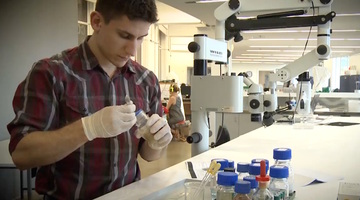Historical artefacts like moa bones can be dated using a technique that measures the activity of the radioisotope carbon-14 still present in the sample. By comparing this with a modern standard, an estimate of the calendar age of the artefact can be made.
To use this interactive, move your mouse or finger over any of the labelled boxes and click to obtain more information.
Select here to view the full transcript and copyright information.

This interactive shows how a moa bone sample is dated using a carbon-14 dating technique. Historical artefacts like moa bones can be dated using a technique that measures the activity of the radioisotope carbon-14 still present in the sample. By comparing this with a modern standard, an estimate of the calendar age of the artefact can be made.
To use this interactive, move your mouse or finger over any of the labelled boxes and click to obtain more information.
Transcript
Moa bone excavated
The Wairau Bar in Blenheim is one of the oldest archaeological sites in New Zealand. Amongst the artefacts that have been found are ancient moa bones. Some of these have been sent to the Waikato Radiocarbon Dating Laboratory for analysis.
Bone cleaned
First, the lab will test the bone to see how much protein remains in it, because it’s the protein fraction of the bone that they actually date. Once they know that there is sufficient protein remaining, they clean the surface of the bone to remove contaminants like dirt, charcoal or, in some cases, glue that the archaeologists have used to mend the bone fragments
Small sample taken and ground into smaller pieces
The cleaned bone sample is then ground up into smaller pieces to speed up chemical reaction with the acid in the next stage.
Further treatments (weak acid added etc.)
The ground-up bone is treated with hydrochloric acid, which dissolves out the hard part of the bone. The remaining material goes through a gelatinisation process to free up the bone protein. Filtration during this phase allows contaminants to be successfully removed.
Freeze dried
The sample is freeze dried to remove excess water. After this process, the resulting material has a spongy texture with an off-white colour. It is now ready for testing.
Series of chemical reactions to convert all carbon atoms present into benzene
The pre-treated sample is loaded onto a quartz silica boat, which is loaded into a combustion tube. It is a long tube which is hooked up to a vacuum line. All air is evacuated from the vacuum line because it has C-14 in it and is a potential contaminant. Then a stream of oxygen is added into the system and the sample is combusted. It is during this stage that the carbon present in the sample is converted into carbon dioxide. The carbon dioxide is collected and bubbled through various chemicals in the line, which purify it, and the amount of carbon dioxide that has been collected is measured.
Formation of benzene (C6H6)
The carbon dioxide formed in the combustion stage is heated in the presence of pure lithium metal, which produces lithium carbide. When all of the carbon dioxide has reacted, distilled water is added to the lithium carbide and a chemical reaction occurs, resulting in the production of acetylene gas. This gas is then passed through a vanadium-based catalyst column, which produces liquid benzene (C6H6).
Addition of scintillator to benzene sample
A scintillator chemical (butyl-PBD) is added to the liquid benzene. Fiona is wearing an aspirator because of the carcinogenic properties of benzene. Special silica glass vials are used to contain the mixture of benzene and PBD.
Liquid scintillator spectrometer counts the number of decays occurring per minute
The silica glass vials are loaded into the liquid scintillation spectrometer. The C-14 atoms present in the benzene decay at a certain rate. The scintillator chemical butyl-PBD picks up each decay event and emits a tiny flash of light that the spectrometer is programmed to detect and count. In addition to the moa sample, control samples are also measured at the same time. The decay events for each sample are measured over a week.
Computer analysis of data
The results from the liquid scintillation spectrometer are carefully analysed and provide a radiocarbon age for the sample. To obtain a calendar age for the sample, this radiocarbon age needs to be compared against samples of known age by means of a calibration curve using a specially designed computer software application. This application uses a terrestrial calibration curve to calculate the calendar age.
Date of sample determined
The moa bone analysis gave a radiocarbon date of 580 plus or minus 40 years. Using the terrestrial calibration curve, a calendar age of AD 1390–1435 was established for the moa bone sample.
Rewriting human history with radiocarbon dating
Professor Tom Higham is director of the Oxford Radiocarbon Accelerator Unit at Oxford University and Principal Investigator for the PalaeoChron Project. Tom completed his PhD at the Waikato Radiocarbon Dating Laboratory.
Learn more about Tom’s work on refining radiocarbon dating and how science is advancing our understanding of human evolution through the Palaeolithic period.



